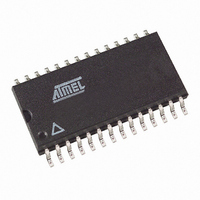TDA4470-MFLG3Y Atmel, TDA4470-MFLG3Y Datasheet - Page 4

TDA4470-MFLG3Y
Manufacturer Part Number
TDA4470-MFLG3Y
Description
IC SOUND PROC VIDEO-IF 28SOIC
Manufacturer
Atmel
Type
Videor
Datasheet
1.TDA4470-MFLG3Y.pdf
(24 pages)
Specifications of TDA4470-MFLG3Y
Applications
VIF/SIF Signal Processing
Mounting Type
Surface Mount
Package / Case
28-SOIC (7.5mm Width)
Lead Free Status / RoHS Status
Lead free / RoHS Compliant
2.4
2.5
2.6
2.7
2.8
2.9
4
Video Demodulation and Amplifier
Sound IF Amplifier and SIF-AGC
AM Demodulator
Quasi Parallel Sound (QPS) Mixer
Standard Switch
L’ Switch
TDA4470
The video IF signal, which is applied from the gain-controlled IF amplifier, is multiplied with the
in-phase component of the VCO signal. The video demodulator is designed for low distortion
and large bandwidth. The demodulator output signal passes an integrated low-pass filter for
attenuation of the residual vision carrier and is fed to the video amplifier. The video amplifier is
realized by an operational amplifier with internal feedback and 8 MHz bandwidth (–3 dB). A stan-
dard dependent DC level shift in this stage delivers the same synchronous level for positive and
negative modulation. An additional noise clipping is provided. The video signal is fed to the
VIF-AGC and to the video output buffer. This amplifier with a gain of 6 dB offers easy adoption of
the sound trap. For a nominal video IF modulation, the video output signal at pin 12 is 2 V
The SIF amplifier is nearly identical with the 3-stage VIF amplifier, except that the first amplifier
stage exists twice and is switchable by a control voltage at pin 3. Therefore, it is possible to
switch between two different SAW filters with minimal external expense. Both SIF inputs fea-
tures excellent cross-talk attenuation and an input impedance which is independent from the
switching condition.
The SIF-AGC is related to the average level of the AM or FM carrier and controls the SIF ampli-
fier to provide a constant SIF signal to the AM demodulator and QPS mixer.
The alignment-free AM demodulator is realized by a synchronous detector. The modulated SIF
signal from the SIF amplifier output is multiplied in phase with the limited SIF signal (AM is
removed). The AF signal of the demodulator output is fed to the output amplifier and to the
SIF-AGC. For all TV standards with negative video modulation (e.g., B/G standard), the AF out-
put signal (pin 25) is switched off by the standard switch.
The QPS mixer is realized by a multiplier. The SIF signal (FM or NICAM carrier) is converted to
the intercarrier frequency by the regenerated picture carrier (quadrature signal) which is pro-
vided from the VCO. The intercarrier signal is fed via an output amplifier to pin 24.
To have equal polarity of the video output signal the polarity can be switched in the demodula-
tion stage in accordance with the TV standard. Additionally a standard dependent DC level shift
in the video amplifier delivers the same sync. level. In parallel to this, the correct VIF-AGC is
selected for positively or negatively modulated VIF signals. In the case of negative modulation
(e.g., B/G standard) the AM output signal is switched off. For positive modulation (L standard)
the AM demodulator and QPS mixer is active. This condition allows a parallel operation of the
AM sound signal and the NICAM-L stereo sound.
With a control voltage at pin 14 the VCO frequency can be switched in order to set required L’
value (L’ standard). Also a fine adjustment of the L’-VCO center frequency is possible via a
potentiometer. The L' switch is only active for positively modulated video IF-signals (standard
switch in L mode).
4803C–TVVCR–10/05
PP
.














